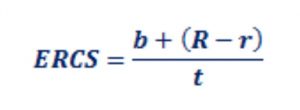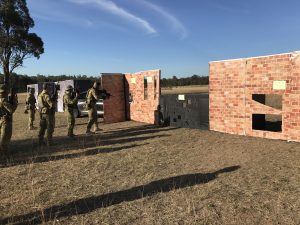Close Combat Shooting is currently one of the primary means of instilling the Combat Mindset in soldiers to develop the pre-combat veteran. Close Combat Shooting does this by increasing the survivability and lethality of the soldier in the 0 – 200-metre zone of combat; however, measuring the effectiveness of soldiers in training at this range can often be difficult to quantify. This article proposes that leaders conducting combat shooting training can use the Effective Rate of Combat Shooting (ERCS) equation to develop training scenarios that achieve their desired learning outcomes, challenge soldiers, and are exciting for soldiers to participate in.
ERCS is defined as a method to score a soldier’s ability to effectively fight through a given scenario utilising appropriate combat behaviors and neutralising all enemy forces. The utility of this quantitative method will be discussed in detail later, but the equation and its applicable variables are expressed mathematically as follows:

ERCS = the Effective Rate of Combat Shooting (points/second)
b = combat behaviours (point)
R = number of rounds of ammunition issued to the soldier (point)
r = number of rounds of ammunition utilised by the soldier (point)
t = time it takes the soldier to complete the event and neutralise all targets (seconds)
The ERCS equation allows trainers to develop and score limitless scenarios based on the desired learning outcomes weighted toward lethality and survivability. An example of such a scenario is the Kill, Move, Communicate (KMC) wall currently in use at the School of Infantry for the Combat Shooting Instructor Course. The KMC wall consists of many apertures of varying size and locations such as windows, doors, corners, and low-cut apertures that simulate firing under a vehicle or gap in a barrier. The firers move along the KMC wall from one direction and engage targets beyond the wall that are set up by the instructors. These targets can be different coloured steel targets, mechanical targets, or any other variety of sizes and shapes to force the combatant to think and identify what target they need to engage, either via pre-lane instruction or as they are on the move executing the lane. Targets can also be adjusted such that they require several hits to be effectively neutralised.

Training and Scoring Lethality.
Lethality is the capacity to cause death or serious harm or damage. In combat, soldiers must be able to apply lethality as quickly and efficiently as possible in any given situation. The variables of the ERCS equation that focus on lethality are the number of rounds utilised to neutralise an enemy (r) and the time it takes to do so (t). A key principle of combat shooting is that a soldier should only go as fast as they can and still effectively engage their target. The fact that speed on the battlefield and the ability to kill the enemy utilising cover and concealment before the enemy can kill you is a reality. If an instructor needs to focus a particular training event on lethality, the number of targets available to shoot can be increased along with the number of rounds issued (R). One of the principles of combat shooting lanes and scenarios is that the firer cannot proceed until the threat they are facing is neutralised; thus, there is often no need to determine the number of targets hit as all firers will have neutralised the same number of targets to complete the lane.
Training and Scoring Survivability.
Survivability is a measure of the combatant’s ability to endure enemy encounters through the use of protective measures and good combat behaviours without injury or death. In combat shooting, improving the survivability of soldiers can be difficult to train; however, scoring good combat behaviours allows instructors to put an increased focus on this critical component of training the combat mindset. The variable of the ERCS equation that focuses on survivability is the combat behaviour variable (b). On any given combat shooting lane, the trainer can develop the scenario such that there is any given amount of combat behaviours to score to achieve the desired outcome. Examples of measurable combat behaviours are the appropriate use of cover from a given firing position, proper muzzle placement from an aperture (ie. keeping the barrel of the weapon behind a window or door frame), post engagement sequences, magazine top-ups and change techniques, etc. In developing the combat shooting lane or scenario the instructor has the ability to weight the desired combat behaviours for focus as they like to achieve the critical learning outcome.
Bringing Survivability and Lethality Together.
After developing a combat shooting lane or scenario that achieves the desired learning outcomes, soldiers can then execute the lane, and the ERCS equation be used for comparative scoring analysis and competition. There is not a single 'good' score for all combat shooting lanes; rather, instructors can use the ERCS score to challenge soldiers to improve their performance. Instructors must trial the lane or scenario they intend to use first so that they can determine the appropriate amount of ammunition to issue soldiers (R), and refine the number of targets and combat behaviours to score during the event. Additionally, by completing the lane several times, the instructors can inform the soldiers of approximately what value would equate to a 'good' score. As a general rule of thumb, a 'very good' result (minimum number of rounds used, all combat behaviours achieved, and a low time to complete the lane) should be a number that the combatants can compare against their peers. Therefore, whole numbers are more desirable than fractions of a point. To achieve this, instructors can also multiply the final result by a multiple of 10 or 100. Regardless of the makeup of the lane, a higher score is always better as it indicates more combat behaviours, fewer rounds utilised, and less time required. However, there may be times when a condition must be placed on the combatants to ensure the desired training outcome is achieved. As an example, there may be a caveat on a particular lane that, though the minimum scores is a stated ERCS, the soldier must achieve at least 50% of all combat behaviours for the iteration to count.
Soldiers desire to know how they are performing compared to their peers or other combatants and want to enjoy their training. The ERCS allows combatants this opportunity in a fun and exciting activity. Well-developed combat shooting lanes can be permanently utilised at unit locations for individuals to continually strive to 'beat' other members in their unit via a record or honour board. Similarly, combat shooting lanes and scenarios could simply be an activity where a platoon or section is allowed to compete against one another for 'top-shot' during that day or training event. Regardless of the exact nature of the competition, allowing such challenges between combatants can be a useful tool for achieving excellence in close combat shooting.
The ERCS methodology for scoring close combat shooting proficiency is a tool that can further enhance the lethality and survivability of all combatants across the Australian Defence Force. It is exportable to any scenario and the design of specific lanes to achieve desired learning outcomes is limited only by the imagination of the trainer. Proper implementation will undoubtedly aid in furthering the Combat Mindset of all soldiers and develop pre-combat veterans that are prepared to win the close combat fight on the next battlefield.









